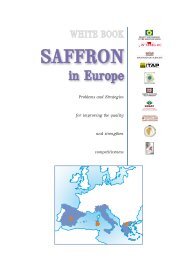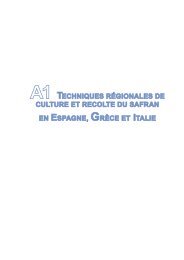Annex White book.pdf
Annex White book.pdf
Annex White book.pdf
Create successful ePaper yourself
Turn your PDF publications into a flip-book with our unique Google optimized e-Paper software.
of saffron plant (Crocus sativus L.) during dormancy and sprouting.Biochem. Physiol. Pflanzen 178, 685-689.Fernández Pérez, J. A., Escribano Martínez, J., (2000). Biotecnología delazafrán. Ediciones de la Universidad de Castilla-La Mancha, Cuenca.Fiori M., Corda P., Carta C., (1983). Pseudomonas corrugata Roberts etScarlett agente della necrosi del midollo del pomodoro (Lycopersicumaesculentum mill.). Rivista di Patologia vegetale, 19, 21-27.Fiori M., (1992). A new bacterial disease of Chrysanthemum: a stem rot byPseudomonas corrugata Roberts et Scarlett. Phitopath. Medit., 31,110-114.Fiori M., 2002. Avversità. In: Zafferano. Storia, Cultura, Coltivazione eImpiego a San Gavino Monreale e in Sardegna. 68-73.Fiori M. Virdis S., Schiaffino A., (2005). A bacterial disease of saffroncaused by Burkolderia gladioli and Pseudomonas spp. XII CongressoNazionale S.I.Pa.V.Scilla (RC). In corso di stampa.Ferri S.; Franchi G.C.; Mazzei E.; Mirali E. y Corti P. (1997) Picrocrocin andcrocetin content in four clones of saffron (Crocus sativus L. –Iridaceae)and some other species of Genus Crocus. Acta Phytother. 3, 34-41.Francesconi, A. (1973). The rotting of bulbs of Crocus sativus L. by Penicilliumcyclopium Westing. Ann. Bot. 32, 63 – 70.Galigani, P.F. y Garbati Pegna, F. (1999). Mechanized saffron cultivation,including harvesting. In Negbi, M. (Ed.) Saffron. Crocus sativus L. Ed.Harwood Academic Publishers. Amsterdam. pg115-126.García Pozuelo, E. (1960). El azafrán. Cultivo y preparación. Hoja Divulgadora4, Ministerio de Agricultura, Madrid, España.Garcia-Jiménez J., Piera V. J., Alfaro Garcia A., (1985). Los “soldatos”,una nueva enfermedad del azafrán (Crocus sativus L.) en España.IV Congreso nacional de Fitopatología. Sociedad española defitopatología. Pamplona Octubre 1985, 76.Garcia-Jiménez J., Alfaro Garcia A., (1987). Fusarium oxisporumSchlecht. as casual agent of a seedborne disease of saffron (Crocussativus L.). Proceedings of the 7th Congress of the MediterraneanPhytopathological Union. September 1987, Granada (Spain), 156.Garrido, J. L.; Díez De Bihencourt, C. y Revilla, E. (1985). El azafrán.Agricultura, Madrid, España.Giaccio M. (1990). Components and features of saffron. In: Lo zafferano– Tammaro F., Marra L. ed.). pg 135-149.Ingram, S. J. (1969). Saffron (Crocus sativus L L.). Trop. Sci. 11, 177-184.Ionita A., H. Iliescu, V. Jinga e E. Iordache, (1995). Macrophomina phaseolina,parazit periculos al plantelor de cultura posibilitati de combatere.Probleme de Protectia Plantelor. 1995, 23: 2, 179-196.ISO 3632-1/2 (1993) Normative. Crocus sativus L. Saffron.Ed. ISO, Geneva,Switzerland.ISO/TS 3632-1/2 (2003) Technical Specification. Crocus sativus L. Saffron.Ed. ISO, Geneva, Switzerland.ITAP. (1998). Especial azafrán. Boletín del Instituto Técnico AgronómicoProvincial de Albacete 34, Albacete, España.Jiménez, J.A. (2003). Estudio de la influencia de diferentes variablesagronómicas en la reproducción de cormos y floración anual. Controlde malas hierbas mediante tratamientos químicos en el cultivo del209




